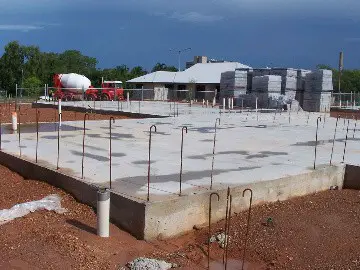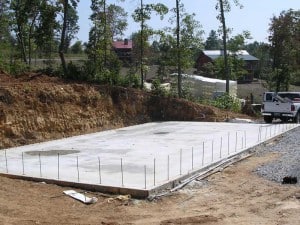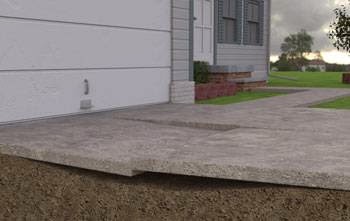Slab on grade foundations are also commonly known as floating slab foundations. The foundation is formed using a mold that is set into the ground rather than digging a basement for the structure. There is no space between the ground and the poured concrete.
Uses of Slab Foundations
Slab foundations are used under the following conditions.
- Slab foundations are usually found in warmer climates. The freezing and thawing effect on the ground is not a concern in warm climates. This negates the need for heat ducts under the floors.
- They are very common in areas that are comprised of clay soil.
- These foundations are the general accepted foundation for tract homes or buildings being quickly built with a low budget.
- Slab foundations are used for sheds, barns and garages to give a sturdy floor without putting out a lot of extra money.

Advantages of Slab Foundations
Slab foundations have many advantages. The advantages of slab foundations are listed below.
- It is inexpensive. The cost is significantly less than doing a full basement or even a crawl space under a building.
- They are sturdy. The building is resting directly on the poured concrete and is not relying on beams and other supports to sustain the building.
- Termites are not a problem. With a concrete slab foundation, there would be no wood touching the ground and being potentially exposed to termites.
- They are an excellent solution for tract homes considering their cost effectiveness.
- Slab foundations are excellent for flooring in a shed, garage or barn.
- Labor costs, forms and excavation are at a minimum. This keeps the costs down and allows for quick builds.

Disadvantages of Slab Foundations
Slab foundations also have some disadvantages that should be considered. The disadvantages of slab foundation includes the followings.
- No access underneath the slab for utility lines and other important cables.
- Heat loss occurs quickly when the ground temperatures fall below the temperature inside the building.
- Floods are a concern. If the slab foundation is located at a low elevation the building can flood even in mild rains.
- Extending the building is not generally possible since it is sitting on a poured concrete slab.
- Slab foundations will settle over time and create problems with the soundness of the building.
- Natural gas and water lines that are laid when the slab is poured will eventually break down over time and will need to be replaced. It is impossible to check the pipes regularly so you must watch for signs of a leak. These include wetness on the floor, water pressure dropping and exterior walls being discolored.

Slab on grade foundations require that all plumbing and electrical be placed below grade or inside the building. All wiring must be placed within water tight conduit and have the ability to be replaced when upgrades or repairs need to be made. While slab on grade foundations are inexpensive and make building go more quickly, the disadvantages outweigh the advantages. For homes, it is best to have a different foundation poured rather than deal with the problems that could occur with a slab on grade foundation.

any source !! thanks 🙂